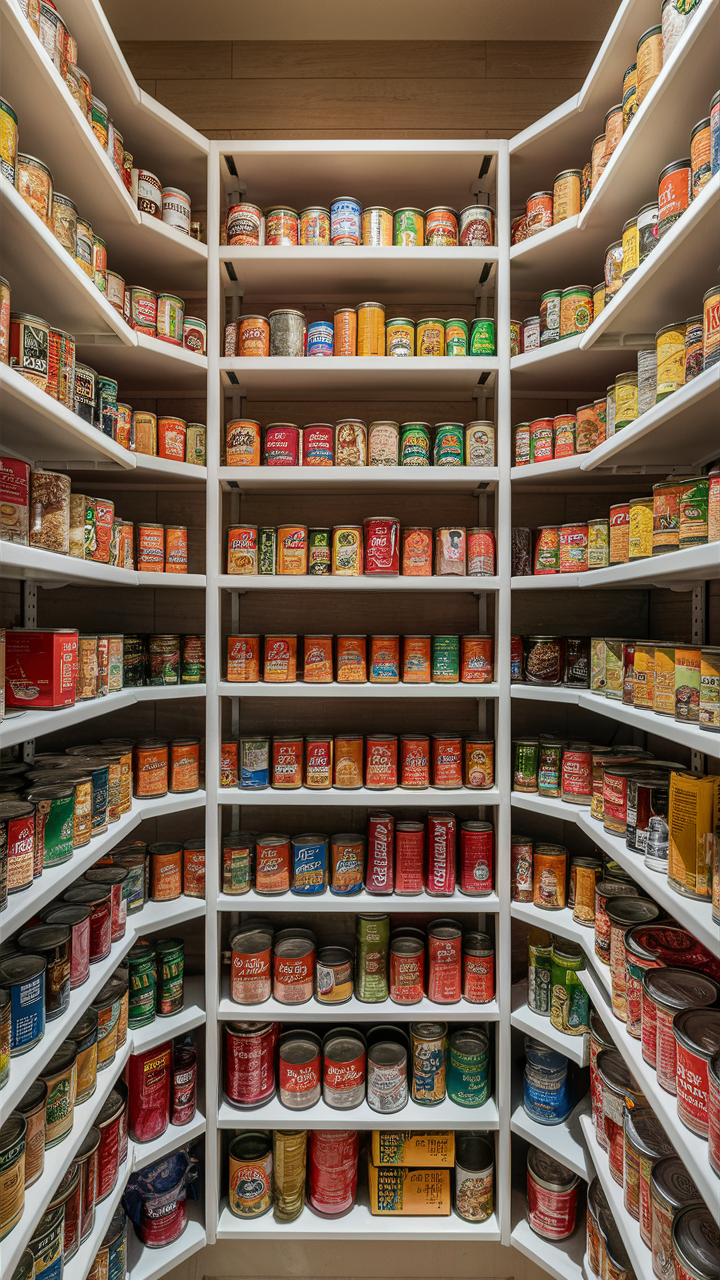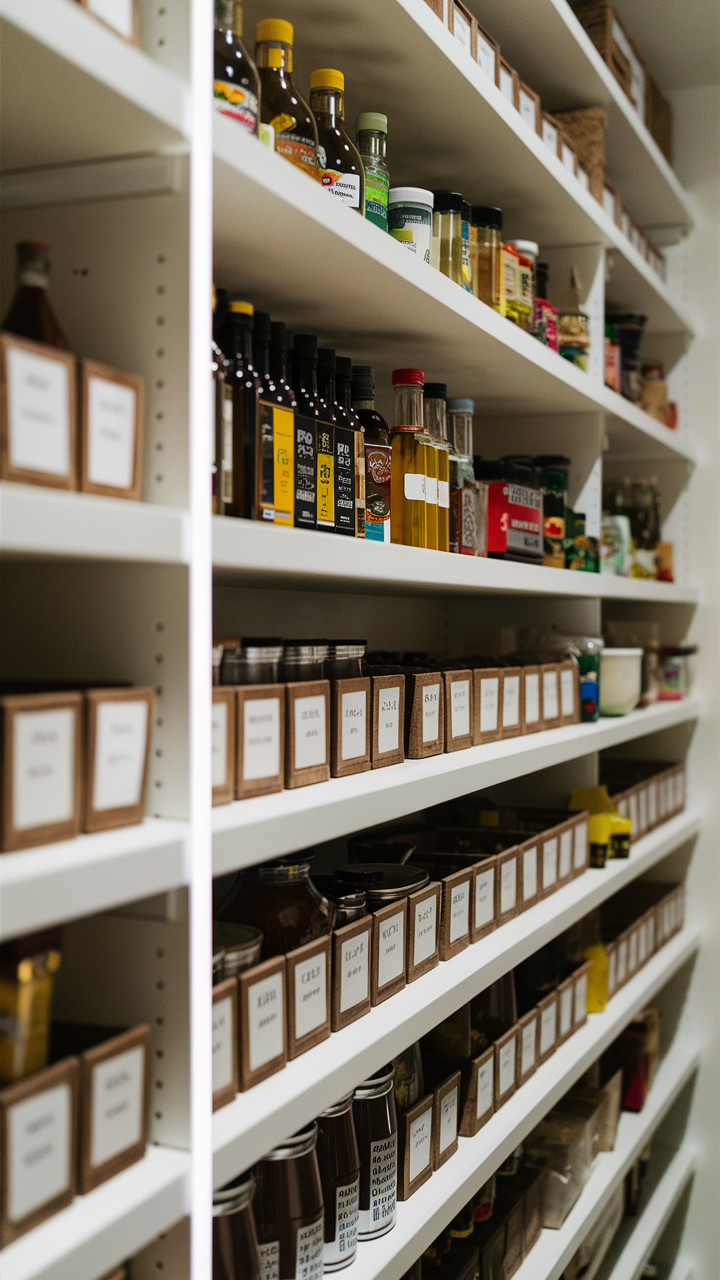22 Creative Pantry Organization Ideas for a Neat and Stylish Kitchen
Keeping your kitchen organizers arranged enables you to look for things more quickly and makes cooking a fun activity. But what if you can do both the jobs of staying organized and being creative at the same time by putting your ideas into visualization? This step-by-step guide will walk you through 22 creative solutions that you can implement in your kitchen. Get ready with your drawing instruments, and let’s go!
Declutter First, then Organize Your Pantry
Jumping into organization ideas for the pantry is good, but we should take a more fundamental picture to start with. Commence by portraying with lines the basics of a rectangle pantry and putting down horizontal lines that symbolize the shelves. A few simple containers should be drawn on the shelves including enough free space for the illustrating of the decluttering process. In a sketch, one can use different shadow areas and lines to show a stage where there was clutter and the changes organization brought in it.
Divide the Pantry into Zones with Different Types of Foods
Setting up the zones of different kinds of meals is an important aspect of a successful pantry arrangement. Show the zone divisions through rectangular pantry shelves, using light lines or subtle dividers to distinguish each area. Label or add small icons for categories such as grains, snacks, and canned goods in order to improve the clarity and make a visually appealing layout.
Label Everything for Easy Identification
In this drawing, make sure to pick an angle where the shelves with several tagged containers can be easily seen. Each label has its own prominence and the arrangement of the containers is good for their quick identification. Apply clean, sharp lines to both the containers and the labels, and see every single one of them being visibly outlined.
Maximize Vertical Space with Shelf Risers
You may represent the use of vertical storage through a drawing of shelves with shelf risers. Included in the drawing has to be a few containers on the lower level and some the risers raised to demonstrate the concept that the riser makes for more storage. Use the perspective of the piece to heighten the contrast between the rising and the dropping, thus revealing the heightened use of vertical space.
Save Pin

Put Money into Drawers and Pull-Out Bins
Draw a pantry with pull-out bins and drawers that will enable easy access to items. Depict the bins in different arrangements, some of which are closed, and some are simply being dejected a bit—that way buyers will focus simple usage. Put one handle on every box to be quite visible and use the shadow effect to alter the depth of the boxes.
Use Lazy Susans for Hard-to-Reach Corners
A technique to show the efficiency of Lazy Susans in the storage of corners is to portray a round rotatable tray placed on a corner shelf. You should include the different jars or containers held in the Lazy Susan as well as make some of those jars placed spin realistically to show the movement of the item. The message the manufacturer wants to convey is that Lazy Susan is round and eye-catching and that it can be used effectively even in the hard-to-reach spots.
Store Canned Goods in Tiered Organizers
Draw the tiered organizer on the pantry shelves carrying a number of cans. Each tier should clearly be the focus, which will demonstrate the well-stacked cans are easy available and in order. Use the same thickness and curvature for each level with a small delta of the one caused by shade grades. you also can make the real image seems more impressive,
Use Stackable Bins to Save Space
Commonly used in pantry areas, stackable bins are very space-efficient. In order to make the pantry look much bigger, begin with a flat rectangular box. Build clothes carts almost on top of one another and then make every path as straight as possible. When you want to have the area with uniform bins but still show the flexibility and ease of storage, keep a consistent width for each bin and a sufficient gap between the bins to leave space for them to be organized. Lightly add shadows to represent the areas changed by over-and-under vision.
Add Adjustable Shelving for Versatility
Mount a telescoping wall shelving bracket to one of the kitchen pantry walls along the sides of the pantry and use them to support the adjustable shelves. Sketch an asymmetrical pantry layout that displays the adjustable brackets along the sides of the shelves. Different heights of shelves, open and closed, to illustrate the adjustable feature. Create the visibility by applying lines with precision and adding still shadows to describe the shelf’s mobility.
Use Wire Baskets for Snacks and Small Items
The wire shelving concept further elaborates these pantry shelve ideas. Diagram the shape of the basket with minimal thickness of the wire outlines. The wire-like characteristics of the small baskets should be exposed so that the viewer knows what is inside the basket. Use gentle curves for the wires and shade the insides lightly to create the sense of space.
Store Spices in a Dedicated Spice Rack
A storage rack is an efficient means of effective storage of numerous small items. Draw the small, narrow multi-compartment rack with tiny container boxes named after various species and their different positions. The drawer should contain the drawers, and the labels should be easily recognizable. This smartly designed accessory truly deserved the statement of fashion in the small space, with being both compact and handy.
Hang Over-the-Door Organizers for Extra Storage
Among the numerous ideas, a convenient solution would be over-the-door organizers, which are not only a cost-effective way to get extra storage in a tight kitchen but also do not require any tools for their installation. On the back of a door, create a template with multiple hanging pockets. Define each pocket as a separate space, and fill them with different delicious snacks or kitchen utensils with no overlap among the pockets. Imbue the hanging pockets with slight dark/light shading to make them stand out and illustrate how uncomplicated this do-it-by-yourself project is.
Use Drawer Dividers for Smaller Items
We can take advantage of the drawer dividers to help organize odds and ends. The first thing you need to do is the drawer from the top view perspective. Create the drawer by laying out the partitions between the sections using straight and sharp lines. Arrange different utensils or kitchen equipment in the compartments. Thus, the dividers can be used efficiently to store kitchen tools in a small space.
Designate a Spot for Frequently Used Items
Setting up a separate shelf for items, which are regularly consumed, is the cleverest way to systematically arrange the pantry. The pantry shelf has three different sections, namely oils, spices, and snacks, and it is displayed on the panel, which is the key part of the design. The simplicity of the line and high-frequency accessibility of typical items are the hewn angles for separation.
Create a Snack Station for Quick Access
The snack station will be able to provide you with everything at one place, so it gives you perfect convenience especially in a busy household. Doodle a rack with bins or baskets placed in neatest order and put different kinds of snacks in it. After you design the storage space, you should clarify the contents of the baskets by labels and darken the background just to give depth the areas
Organize Baking Supplies in Clear Jars
Clear jars are the best solution for the organization of the baking ingredients. Use the shelf space you like the most and bring these jars out of the pantry as if they are complete with what they house. One can use flour, sugar, and cocoa powder as examples, but a collection of ingredients can be anything. Let the jars become more transparent than the previous model, and clearly see the names of the products they contain. In addition to that, you can use the effect of illumination to add realism to the jars and at the same time, give a glimpse of extra storage space.
Use Wicker Baskets for a Stylish Touch
Wicker baskets are an easy and affordable style to add a touch of natural and modern rural area among the pantry. You can draw a number of wicker baskets on storage shelves, first, make a plan to show how the weave would look like then do the actual drawing. The baskets must be open at the very top, with the fruits, and veggies that will be recognizable inside. The wave lines should be the ones you use to create a lifelike, wicker-weave texture.
Put Root Vegetables in a Cool, Dark Space
It is important to keep root vegetables like potatoes and onions to thrive in a cool, dark space. To explain this, draw in the cupboard of storage with the elements of realism: wood material, under-positioned, deep wooden crates, or bins are the spaces in which the artichokes will be stock. The bins should be able to rest in the opening, so some of the slotted space for airflow is below. To prove the point, add a dark background effect to bring out the darkness of the room and thus emphasize the lighter pantry shelves high above.
Employ Magnetic Strips to Hang Containers
Putting a magnetic strip up is one of the cleverest ways to hang those metal containers in a pantry. An initial sketch may have a broad strip horizontally hanging from the kitchen pallet at a level where the large containers rest. Hang a few lightweight small round or rectangular containers under that. The illustration should be precise to express the containers are hanging securely, and a degree of shading should be added to give a sense of depth. The shine should be trendy and sophisticated.
Suspend Hooks for Reusable Shopping Bags
One of the simplest ways to make your pantry organized is to hang hooks for the reusable shopping bags. Then, sketch a descriptive part of a wall with different hooks for hanging the shopping bags. The bags should be detailed in a way that the hook with slight lines will make the bag look like it is moving. Simple cleanup lines and minimalist backgrounds call for the attention of the hooks and bags.
Keep Non-Food Items Separated From Foods
Keeping non-food items apart from food will help you have an organized and safe pantry. Name two distinct zones within the pantry, one that comprises only non-food items like cleaning supplies, and the other that receives only edible products. Piece by piece let the lines help us notice the entire segments and then, draw one point for separation of the non-food section visually. Differentiate the non-food items by making them slightly darker visually from the items, implying that there is a separation.
Install Lights for the Pantry to be More Clearly Visible
Using light does enhance the functionality of the pantry. To start, sketch a bird’s eye outline of the pantry and install LED lamps under the shelves. Depict the light coming into the pantry shelves and reflect the stored items, by first drawing the light as shown in the designated area below the shelves. Use lines and shading to show the glow effect of the lights, which makes the place look bright and well-organized.
Save Pin
